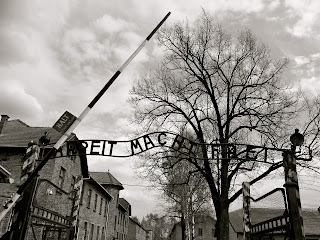Today I went to Auschwitz-Birkenau.
Why visit Auschwitz-Birkenau? For me, it was a life-altering experience, but it also helped to vindicate my decision to pursue this field to study. Seeing this notorious concentration camp, which is one of the most moving sights in Europe, and is certainly the most important of all the Holocaust memorials, has left with with even more questions and a determination to pursue these inquiries through research and further education. I don't know how someone can deny any aspect of the Holocaust after walking through the site where one of humanity's most unspeakably horrifying tragedies occurred. At least 1.1 million innocent people perished here. All over the world, Auschwitz has become a symbol of terror, genocide, and the Holocaust.
On the way to Auschwitz. For this trip, we traveled by road on a tour bus, but I couldn't help but think about how many victims traveled along this path to an unknown destination where their fate was decided for them. Auschwitz was established by the Nazis in 1940, in the suburbs of Oswiecim. Today, Auschwitz is in the middle of a residential area. It is a place that is screaming to remember and to never forget, but all around it, it is fighting tourists, and today's intruding world.
For the next part, I am going to comment on some of the pictures that I was able to take while visiting the two camps. It was hard for me to take pictures, but the ones that I managed to take, will be memorable. You just can't capture the essence or atmosphere of Auschwitz-Birkenau in pictures. Going in April, it was ironically beautiful. Flowers were in bloom and the grass was green. But the atmosphere was gloomy with all of its looming history and unspeakable crimes.
 |
| The notorious gate with the cruel message, "Work Sets You Free. " However on arrival, new prisoners were told the truth: the only way out of the camp was through the crematorium chimneys. |
 |
| This wall, located in the courtyard between block 10 and 11 is where the Nazis shot several thousand political prisoners, leaders of camp resistance and religious leaders. |
 |
| Words can't even describe how it felt to see the crematorium. |
 |
| View of Auschwitz I |
 |
| "For ever let this place be a cry of despair and a warning to humanity where the Nazis murdered about one and a half million men, women, and children mainly Jews from various countries of Europe." |
 |
| Latrine-there was no running water; prisoners were in charge of keeping these clean. |
I could have spent so much longer walking around the camps and thinking up questions. Luckily, since I will be in Krakow for another two months, I have the opportunity to return and experience it again through different lens (meaning company). Next week I will be coming back with one of my classes, "Jews in Central Europe" and touring it with my professor and my three other classmates. We are all required to do an oral presentation on a topic relating to Auschwitz-Birkenau. I know that I will be returning here again.
----------------------------------------------------------------------------------------------------------------------------------
For more information visit Auschwitz-Birkenau Memorial Museum home page: http://en.auschwitz.org/m/
Recommended readings for stories related to Auschwitz:
This Way to the Gas, Ladies and Gentlemen Tadeusz Borowski
Night Elie Wiesel
I Was Doctor Mengele's Assistant Miklos Nyiszli
Survival In Auschwitz Primo Levi
The Diary of a Young Girl-Diary of Anne Frank-Anne Frank





No comments:
Post a Comment